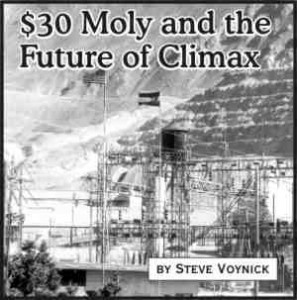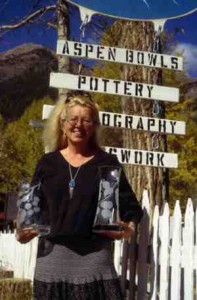Review by Steve Voynick
Mining – July 2005 – Colorado Central Magazine
A Room for the Summer: Adventure, Misadventure, and Seduction in the Mines of the Coeur d’Alene
by Fritz Wolff
Published in 2005 by University of Oklahoma Press
ISBN: 0-8061-3658-8
MINING HAS BEEN a hot topic lately in Colorado, with lots of talk about renewing oil-shale development near Rifle and reopening the Climax Mine at Leadville. Despite the current dearth of mining in Central Colorado, interest in what was once this region’s traditional economic and cultural base remains strong, and that’s reason enough to read Fritz Wolff’s A Room for the Summer. Wolff’s book is a personal memoir of his hardrock-mining experiences during the late 1950s at the legendary Bunker Hill Mine in northern Idaho’s Coeur d’Alene district.
Wolff spent just three summers working as a hardrock miner, time enough to earn tuition money while attending the New Mexico School of Mines (now New Mexico Tech). But hardrock mining doesn’t take long to create indelible memories.
“The experience was my boot camp, my primary training,” Wolff writes, “that place where we all get started one way or another.”
To explain the book’s title, Wolff recounts how, as an 18-year-old, green-behind-the-ears kid, he left his home in an affluent Seattle neighborhood in 1956 to take a summer job at the Bunker Hill Mine in Kellogg, Idaho. Upon arriving, he stopped at what he thought was a boardinghouse and courteously asked to rent “a room for the summer.” His request met with grins and laughter, for Wolff had actually knocked on the door of a whorehouse, one of several that were then flourishing in the rough mining camp.
In recalling his introduction to hardrock mining, Wolff’s vivid descriptions of man trains and rattling descents on wooden skips down a 6,900-foot-long decline sweep the reader into the darkness, stifling heat, and deafening roar of the drills that permeated the Bunker Hill Mine. The Bunker Hill was then a world-class silver mine, with the extent of its sprawling underground workings actually exceeding those of the Climax Mine.
Most of Wolff’s shifts consisted of standing square-set timbers, mucking out, drilling rounds, tamping powder, and spitting fuses, a routine that was occasionally interrupted by such unnerving but necessary tasks as walking back into misfires and retimbering cave-ins. Wolff has a good knack for realistically recreating miners’ dialogue, and his well-written, concise descriptions of mining procedures make the book enjoyable and meaningful for both miners and non-miners alike.
A ROOM FOR THE SUMMER reminded me of the remarkable similarities of expression, perspective, and vernacular shared by all western hardrock miners. From Wolff’s descriptions, the Bunker Hill could have easily been the Eagle Mine at Gilman or the Climax Mine.
Kellogg in the late 1950s could also have been Leadville during that same time period. Wolff writes of off-shift experiences such as searching the backcountry for an old mine whose history he has researched, living in and taking meals at a boardinghouse, witnessing a payday-night barroom fight, and even nervously bartending a cocktail party for some top mining executives.
Wolff began writing this book about 40 years after the fact. From his rich descriptions, I initially suspected — wrongly, as it turned out — that he drew his detail from a stack of personal journals. “I am lousy at keeping journals but fortunately have a fair memory,” Wolff admits. “Not everything stuck, of course, but some of those things you learn early on–particularly when your life or your partner’s life depended on it–are still there, firmly implanted.”
Wolff left Kellogg in 1960 with a mining-engineering degree and moved on to the Wyoming uranium fields. From there, an advanced degree led to a career in the aerospace industry. Today, Wolff is the principal investigator for the Geology Division of the Washington Department of Natural Resources, where he collects data on inactive and abandoned mines.
THROUGH ALL OF HIS career changes, Wolff never forgot his youthful experiences at the Bunker Hill Mine, and “had been writing the story in his mind for quite a while–not entirely sure that it was worth the telling.” Then, in the early 1990s, a teenager commented that because Wolff’s story had taken place decades earlier, it had become “a history kind of thing.” Wolff then realized that hardrock mining had undergone radical changes since his days underground. From that perspective, his Bunker Hill experiences represented direct involvement in what had already become western mining history and was indeed “worth the telling.”
Although the author began writing this book in 1995, it took years to track down his old Bunker Hill friends and mining partners. Interviews with them helped refresh his memories about his own underground experiences.
The book ends on a note of sadness. Returning to Kellogg recently, Wolff finds that some of his former underground partners had passed away, that the establishment where he first sought “a room for the summer” had become a melodrama theater, and that much of the Bunker Hill Mine had long since been flooded. Wolff laments that the popular perception of the Bunker Hill today is not as a mine that produced a phenomenal 430 million troy ounces of silver while providing a living for thousands of families over a century; instead it’s generally regarded only as an Environmental Protection Agency Superfund site.
Fritz Wolff has made a solid contribution to mining literature. Whether you’re a hardrock miner, mining-history buff, or just someone looking for an engaging treatment of an unusual slice of recent western history, A Room for the Summer is well worth reading.


